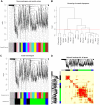Network-based identification of signature genes KLF6 and SPOCK1 associated with oral submucous fibrosis
- PMID: 32190310
- PMCID: PMC7058035
- DOI: 10.3892/mco.2020.1991
Network-based identification of signature genes KLF6 and SPOCK1 associated with oral submucous fibrosis
Abstract
The molecular mechanism of oral submucous fibrosis (OSF) is yet to be fully elucidated. The identification of reliable signature genes to screen patients with a high risk of OSF and to provide oral cancer surveillance is therefore required. The present study produced a filtering criterion based on network characteristics and principal component analysis, and identified the genes that were involved in OSF prognosis. Two gene expression datasets were analyzed using meta-analysis, the results of which revealed 1,176 biologically significant genes. A co-expression network was subsequently constructed and weighted gene modules were detected. The pathway and functional enrichment analyses of the present study allowed for the identification of modules 1 and 2, and their respective genes, SPARC (osteonectin), cwcv and kazal like domain proteoglycan 1 (SPOCK1) and kruppel like factor 6 (KLF6), which were involved in the occurrence of OSF. The results revealed that both genes had a prominent role in epithelial to mesenchymal transition during OSF progression. The genes identified in the present study require further exploration and validation within clinical settings to determine their roles in OSF.
Keywords: eigengene; epithelial to mesenchymal transition; meta-analysis; module; protein-protein interaction; singular value decomposition; weighted gene co-expression network analysis.
Copyright: © Singh et al.
Figures






Similar articles
-
Comparative molecular analysis of oral submucous fibrosis and other organ fibrosis based on weighted gene co-expression network analysis.Zhong Nan Da Xue Xue Bao Yi Xue Ban. 2022 Dec 28;47(12):1663-1672. doi: 10.11817/j.issn.1672-7347.2022.220452. Zhong Nan Da Xue Xue Bao Yi Xue Ban. 2022. PMID: 36748376 Free PMC article.
-
SPOCK1 promotes metastasis in pancreatic cancer via NF-κB-dependent epithelial-mesenchymal transition by interacting with IκB-α.Cell Oncol (Dordr). 2022 Feb;45(1):69-84. doi: 10.1007/s13402-021-00652-7. Epub 2021 Dec 2. Cell Oncol (Dordr). 2022. PMID: 34855159
-
Proteoglycan SPOCK1 as a Poor Prognostic Marker Promotes Malignant Progression of Clear Cell Renal Cell Carcinoma via Triggering the Snail/Slug-MMP-2 Axis-Mediated Epithelial-to-Mesenchymal Transition.Cells. 2023 Jan 17;12(3):352. doi: 10.3390/cells12030352. Cells. 2023. PMID: 36766694 Free PMC article.
-
Signaling pathways promoting epithelial mesenchymal transition in oral submucous fibrosis and oral squamous cell carcinoma.Jpn Dent Sci Rev. 2020 Nov;56(1):97-108. doi: 10.1016/j.jdsr.2020.07.002. Epub 2020 Aug 22. Jpn Dent Sci Rev. 2020. PMID: 32874377 Free PMC article. Review.
-
SPOCK1: a multi-domain proteoglycan at the crossroads of extracellular matrix remodeling and cancer development.Am J Cancer Res. 2020 Oct 1;10(10):3127-3137. eCollection 2020. Am J Cancer Res. 2020. PMID: 33163261 Free PMC article. Review.
Cited by
-
Exploring the role of miR-200 family in regulating CX3CR1 and CXCR1 in lung adenocarcinoma tumor microenvironment: implications for therapeutic intervention.Sci Rep. 2023 Sep 28;13(1):16333. doi: 10.1038/s41598-023-43484-1. Sci Rep. 2023. PMID: 37770496 Free PMC article.
-
Circulating miRNA-181b-5p, miRNA-223-3p, miRNA-210-3p, let 7i-5p, miRNA-21-5p and miRNA-29a-3p in patients with localized scleroderma as potential biomarkers.Sci Rep. 2020 Nov 19;10(1):20218. doi: 10.1038/s41598-020-76995-2. Sci Rep. 2020. PMID: 33214624 Free PMC article.
-
Inhibition of miR-497 Attenuates Oral Submucous Fibrosis by Inhibiting Myofibroblast Transdifferentiation in Buccal Mucosal Fibroblasts.Oral Health Prev Dent. 2022 Aug 3;20:339-348. doi: 10.3290/j.ohpd.b3276183. Oral Health Prev Dent. 2022. PMID: 35920886 Free PMC article.
-
Unravelling the Role of miR-20b-5p, CCNB1, HMGA2 and E2F7 in Development and Progression of Non-Small Cell Lung Cancer (NSCLC).Biology (Basel). 2020 Aug 1;9(8):201. doi: 10.3390/biology9080201. Biology (Basel). 2020. PMID: 32752229 Free PMC article.
-
Integrative Multiomics and Regulatory Network Analyses Uncovers the Role of OAS3, TRAFD1, miR-222-3p, and miR-125b-5p in Hepatitis E Virus Infection.Genes (Basel). 2022 Dec 23;14(1):42. doi: 10.3390/genes14010042. Genes (Basel). 2022. PMID: 36672782 Free PMC article.
References
-
- Ekanayaka RP, Tilakaratne WM. Oral submucous fibrosis: Review on mechanisms of pathogenesis and malignant transformation. J Carcinog Mutagen, 2013. Available from: https://www.omicsonline.org/oral-submucous-fibrosis-a-clinico-histopatho.... - PubMed
LinkOut - more resources
Full Text Sources
Miscellaneous
